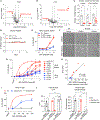De novo pyrimidine synthesis is a targetable vulnerability in IDH mutant glioma
- PMID: 35985343
- PMCID: PMC9515386
- DOI: 10.1016/j.ccell.2022.07.011
De novo pyrimidine synthesis is a targetable vulnerability in IDH mutant glioma
Abstract
Mutations affecting isocitrate dehydrogenase (IDH) enzymes are prevalent in glioma, leukemia, and other cancers. Although mutant IDH inhibitors are effective against leukemia, they seem to be less active in aggressive glioma, underscoring the need for alternative treatment strategies. Through a chemical synthetic lethality screen, we discovered that IDH1-mutant glioma cells are hypersensitive to drugs targeting enzymes in the de novo pyrimidine nucleotide synthesis pathway, including dihydroorotate dehydrogenase (DHODH). We developed a genetically engineered mouse model of mutant IDH1-driven astrocytoma and used it and multiple patient-derived models to show that the brain-penetrant DHODH inhibitor BAY 2402234 displays monotherapy efficacy against IDH-mutant gliomas. Mechanistically, this reflects an obligate dependence of glioma cells on the de novo pyrimidine synthesis pathway and mutant IDH's ability to sensitize to DNA damage upon nucleotide pool imbalance. Our work outlines a tumor-selective, biomarker-guided therapeutic strategy that is poised for clinical translation.
Keywords: DHODH; IDH; cancer metabolism; genetically engineered mouse model; glioma; isocitrate dehydrogenase; pyrimidine nucleotides.
Copyright © 2022 The Author(s). Published by Elsevier Inc. All rights reserved.
Conflict of interest statement
Declaration of interests R.J.D., W.G.K., and S.K.M. have served as paid advisors to Agios Pharmaceuticals. W.G.K. receives compensation for roles as an Eli Lilly and LifeMine Therapeutics Board Director, a founder of Tango Therapeutics and Cedilla Therapeutics, and a scientific advisor for Fibrogen, IconOVir Bio, Circle Pharma, Nextext Invest, and Casdin Capital. K.L.L. receives research support from Eli Lilly and Company via the DFCI. S.K.M. and W.G.K. received research funding from Bayer Pharmaceuticals. Bayer had no influence over the design, execution, or interpretation of studies. N.Y.R.A. is key opinion leader for Bruker Daltonics, scientific advisor to Invicro, and receives support from Thermo Finnegan and EMD Serono. S.G., A.S., M.S., A.J., and L.E. are employees at Bayer. S.G., A.S., and A.J. hold stock in Bayer. D.P.C. has consulted for Lilly, GlaxoSmithKline, and Boston Pharmaceuticals and serves on the advisory board of Pyramid Biosciences, which includes an equity interest. All other authors declare no competing interests.
Figures








Comment in
-
Gliomas lean on pyrimidines.Nat Rev Cancer. 2022 Nov;22(11):606-607. doi: 10.1038/s41568-022-00515-9. Nat Rev Cancer. 2022. PMID: 36131135 No abstract available.
References
-
- Bardella C, Al-Dalahmah O, Krell D, Brazauskas P, Al-Qahtani K, Tomkova M, Adam J, Serres S, Lockstone H, Freeman-Mills L, et al. (2016). Expression of Idh1R132H in the murine subventricular zone stem cell niche recapitulates features of early gliomagenesis. Cancer Cell 30, 578–594. 10.1016/j.ccell.2016.08.017. - DOI - PMC - PubMed
-
- Bothe HW, Bodsch W, and Hossmann KA (1984). Relationship between specific gravity, water content, and serum protein extravasation in various types of vasogenic brain edema. Acta Neuropathol. 64, 37–42. - PubMed
Publication types
MeSH terms
Substances
Grants and funding
- F30 CA183474/CA/NCI NIH HHS/United States
- F30 CA271634/CA/NCI NIH HHS/United States
- P01 CA120964/CA/NCI NIH HHS/United States
- R35 CA220449/CA/NCI NIH HHS/United States
- R01 CA188652/CA/NCI NIH HHS/United States
- P50 CA211015/CA/NCI NIH HHS/United States
- R01 CA258586/CA/NCI NIH HHS/United States
- P41 EB028741/EB/NIBIB NIH HHS/United States
- P30 CA006516/CA/NCI NIH HHS/United States
- P50 CA165962/CA/NCI NIH HHS/United States
- U54 CA210180/CA/NCI NIH HHS/United States
- T32 EB025823/EB/NIBIB NIH HHS/United States
- U19 CA264504/CA/NCI NIH HHS/United States
- P50 HD103557/HD/NICHD NIH HHS/United States
- P50 CA101942/CA/NCI NIH HHS/United States
- K22 CA237752/CA/NCI NIH HHS/United States
- T32 GM007753/GM/NIGMS NIH HHS/United States
- R35 CA210068/CA/NCI NIH HHS/United States
LinkOut - more resources
Full Text Sources
Other Literature Sources
Medical
Molecular Biology Databases
Research Materials
Miscellaneous

